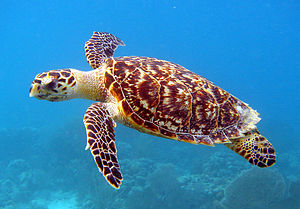Hawksbill sea turtle
| Hawksbill sea turtle | ||||||||||||
|---|---|---|---|---|---|---|---|---|---|---|---|---|

Hawksbill sea turtle ( Eretmochelys imbricata ) |
||||||||||||
| Systematics | ||||||||||||
|
||||||||||||
| Scientific name of the genus | ||||||||||||
| Eretmochelys | ||||||||||||
| Fitzinger , 1843 | ||||||||||||
| Scientific name of the species | ||||||||||||
| Eretmochelys imbricata | ||||||||||||
| ( Linnaeus , 1766) |
The hawksbill sea turtle ( Eretmochelys imbricata ) is a representative of the sea turtle . It is a maximum of 90 cm long and weighs a maximum of 75 kg. The horn plates of the armor of these animals overlap and, as a real tortoiseshell, represent the most valuable form of the coveted raw material for arts and crafts and jewelry . The head of the animals is very narrow. The adults are usually black to dark brown and have yellowish and light brown, sometimes reddish spots and bands.
Surname
The name “ hawksbill sea turtle ” comes from the Spanish carey , which, like the English name Hawksbill sea turtle, alludes to the resemblance of the head to that of a bird of prey. In the past, this species was confused with another, which today bears the name Loggerhead Turtle ( Caretta caretta) in German (and similarly in Dutch) and is more related to the hybrid turtle than to Eretmochelys .
Subspecies
There are two subspecies of the hawksbill sea turtle:
- The Pacific hawksbill turtle ( Eretmochelys imbricata bissa ) is native to the north of Madagascar , in the Malay Archipelago and off the northeast coast of Australia . It used to be widespread on the Pacific coast of Mexico, but has become extremely rare there. The occurrence of the animals is often linked to coral reefs , there are all age groups except hatchlings. It is believed that this species migrates less than the other sea turtles. The subspecies can be recognized by the fact that the carapace of this species is rather rounded at the back. The keel of the carapace can be found consistently on all vertebral shields.
- The Caribbean or Atlantic hawksbill sea turtle ( Eretmochelys imbricata imbricata ) lives in the waters of the Caribbean . The largest occurrence is in Mexico, where they can be found in almost every coral reef. The carapace tapers in this species at the rear end. The keel of the carapace can only be seen on the last four vertebral shields.
Way of life
Hawksbill sea turtles can be found in the open ocean as well as in mangrove swamps and estuaries, but their main habitat is probably clear, shallow coral reefs. Their diet consists of sponges , rib jellyfish and cnidarians , including poisonous representatives. The hawksbill sea turtle mainly eats sponges that live in the reefs, which they peck out with their narrow jaws. The Caribbean or Atlantic hawksbill turtle primarily eats molluscs and coral polyps. Sea algae complement the diet of both subspecies, whereby young animals do not yet consume plant-based food. It is estimated that Hawksbill sea turtles can live to be 30 to 40 years old.
Reproduction
The hawksbill sea turtle becomes sexually mature at around three to 4.5 years of age. The mating of the turtles, which takes place exclusively in the water, can go on for hours. The males hold onto the shells of the females with their elongated and curved claws.
The time of oviposition is different:
- In the Andamans , egg-laying takes place between August and January
- On the Indian mainland, females lay clutch all year round. The peak, however, is in the months of June to October
- On the east coast of Sri Lanka , eggs are laid between April and June
- On the west coast of Sri Lanka, however, the nesting pits are created between November and February.
- In the Maldives , eggs are laid all year round. The peak falls here on the month of December.
- On the Turtle Islands in the Sulu Sea .
The clutches are very large and contain between 96 and 177 eggs. The incubation period until the hatchlings last between 57 and 64 days.
Danger
Hawksbill sea turtles were hunted intensively because of their meat, eggs and especially the tortoise shell. The consumption of the meat is by no means safe for humans. If the animals have previously eaten poisonous marine animals or plants, the meat of the hawksbill sea turtle can also be dangerous for humans. More than 500 such cases have been documented for India, 100 of which were fatal.
The extremely high value of the tanks makes protecting the animals much more difficult. Today both subspecies are threatened with extinction and are under international protection through the Washington Convention on Endangered Species .
literature
- Indraneil Das: The turtles of the Indian subcontinent , Edition Chimaira, Frankfurt am Main 2001, ISBN 3-930612-35-6 .
Web links
- Eretmochelys imbricata in the endangered Red List species the IUCN 2006. Posted by: Red List Standards & Petitions Subcommittee, 1996. Retrieved on 11 May, 2006.
- The Sea Turtle Restoration Project
- Eretmochelys imbricata in The Reptile Database
- Project to protect sea turtles
Individual evidence
- ^ Peter CH Pritchard : Encyclopedia of Turtles . TFH Publications Inc. Ltd., Neptune 1979, ISBN 0-87666-918-6 , p. 693
- ↑ Das, p. 47.
- ↑ Mark O'Shea et al. a .: Herpetological Diversity of Timor-Leste Updates and a Review of species distributions. In: Asian Herpetological Research. 2015, 6 (2): pp. 73-131., Accessed on July 17, 2015.
- ↑ a b Das, p. 48.
- ↑ http://whc.unesco.org/en/tentativelists/5032
- ↑ Das, p. 50.


